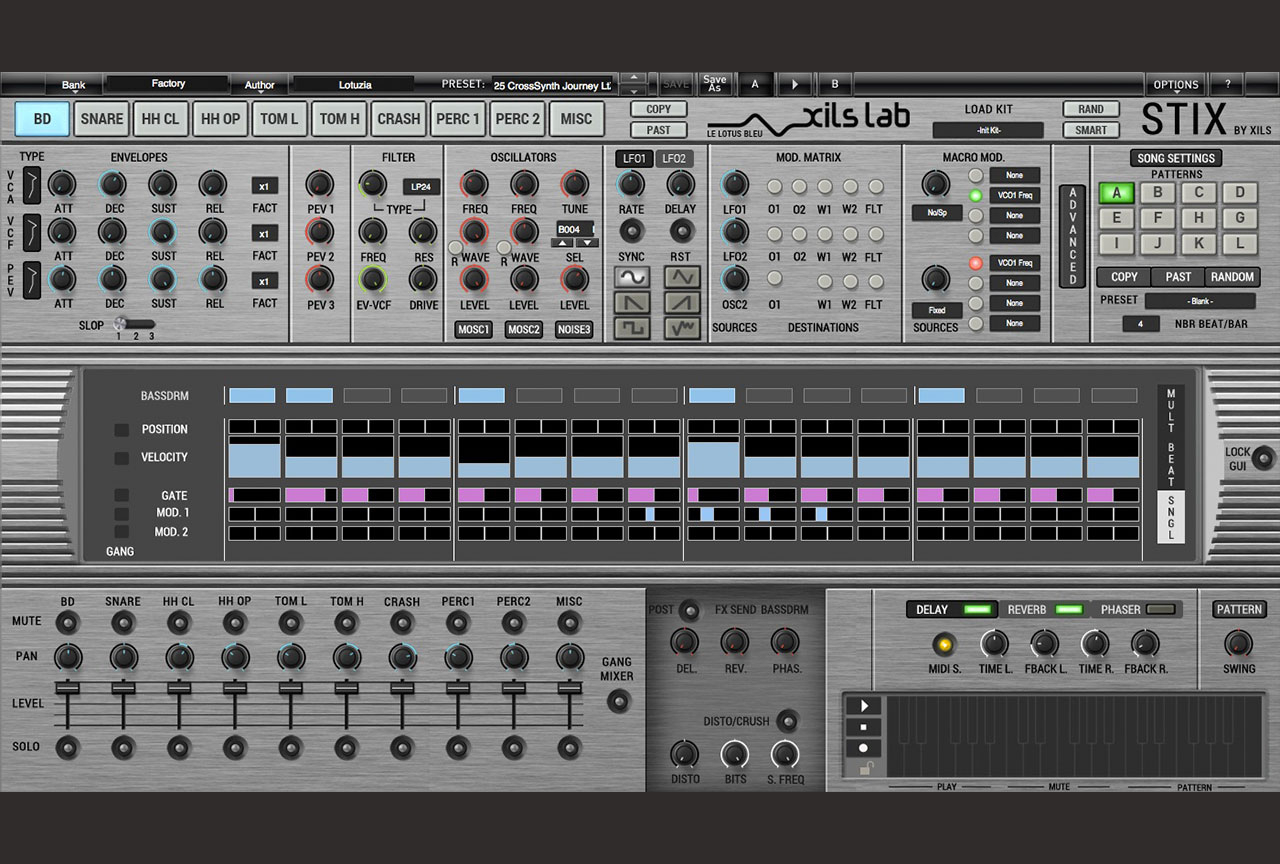- Xils-Lab have a taste for emulating esoteric synthesisers, but in addition to modelling their sound, they try to capture their spirit. For example, the Xils-3 was a satisfying emulation of the VCS-3 that retained its iconic pegboard in the software version. With StiX, they turn their attention to drum machines. But rather than emulating any one unit, Xils-Lab have introduced experimental features to a blueprint based on classic units.
By clearly focusing on its quirkier traits, StiX packs a lot into an easy-to-use interface. You can see this in the modulation section. For each hit, there are four sections on the fascia where you can implement modulation. The polystep feature is particularly interesting. After assigning mod sources to an x-y pad, you can select several points in a cycle to introduce variation. For instance, an odd number of points can create pleasing variations that shift across bars.
The modulation matrix lets you assign an oscillator frequency or LFO to modulate waveform, pitch and filter cutoff, while the macro mod section gives straightforward source-to-destination mapping between two sources and eight destinations. There's no cross-modulation between parts, which would push things even further, but the upshot is that you can easily create sequences with loads of movement and variation. As such, StiX is more prone to wild variations in output than most VSTs, so take care to place a limiter on the channel.
The second area where StiX breaks the mould is the sequencer. Users can split any beat of any part into a number of hits from one to 16, including unusual choices like seven or eleven. Similarly, you can split each hit into further sub-divisions and set the number of beats in the bar to create irregular time signatures. However, you can't loop different parts over different sequence lengths, which would add to StiX's polymetric capabilities. Nevertheless, there is plenty of room for geeky, mathematical sequences and dense, chaotic creations. Unfortunately, the software can lose track of what it should be doing, especially when you push it hard. It's one of a number of areas where bugs are still apparent, and this can make it frustrating and difficult to really work with these features properly.
Underneath the bells and whistles is a solid drum machine. This comes through in the sounds themselves, which are tough, heavy and pack an analogue punch. The sample collection is sizeable, and you can import your own sounds, too. Two oscillators can be layered atop each sample, both of which are adjustable in pitch, waveform and level. In my experience, a separate amp envelope or filter would've made this type of layering more valuable. However, there are per-hit amp and filter envelopes and a pitch envelope for each oscillator.
Xils-Lab modelled these envelopes on the RSF Kobol, a French synth from the late '70s famous for its quick envelopes. It's proven a good choice: raw snappiness is a hallmark of StiX's sound. There's a traditional ADSR option and an envelope called R-CLAP, which retriggers a sample multiple times, mimicking how drum machines create a clap sound with numerous, repeated hits. Both envelopes can be pushed to extremes and are capable of a wide variety of timbres. You can also mix down within the plug-in thanks to a set of controls including EQ, level, pan and sends to a delay, phaser and reverb. If you'd prefer more control, you can also use a multi-out function for mixing with your DAW.
Despite StiX's advanced capabilities, there are straightforward features that make arranging patterns into full tracks a breeze. Your controller keyboard is split into sections for notes, pattern triggers and part mutes. This allows you to spontaneously reel off a structure, add single hits and fills in real time. The keyboard notes and drum hits they trigger aren't mapped sequentially, though, which can disrupt this process. Perhaps there's a reason, but even so, this and the other bugs in StiX are significant enough that they should have been corrected before the full release. You should check whether the bugs mentioned here would significantly impact your own process before deciding whether to buy this version—I tested v1.01—or to wait for an upgrade. StiX also uses a lot of processing power for a drum plug-in, so some optimisation might be in order as well. Their website points out that bug fixes and new features are on their to-do list, so you can probably expect these things to be fixed in the near future.
Nevertheless, StiX is promising. It delivers cone-punching sounds that cut through the mix and drive a track. But it also thinks a little outside the box and pushes the classic X0X layout into welcome new directions. With a bit more market-readiness and development on its current strengths, it could become a much-loved device.
Ratings /
Cost: 3.5
Versatility: 4.3
Sound: 4.3
Ease of use: 4.4
